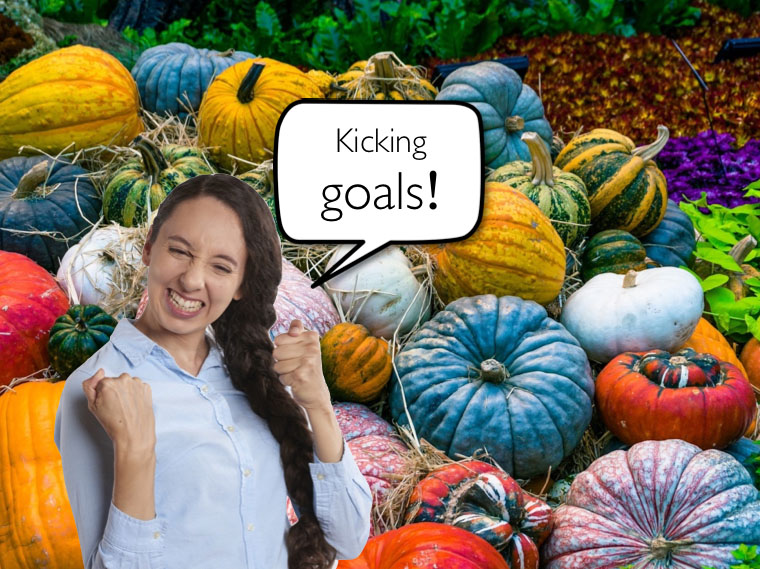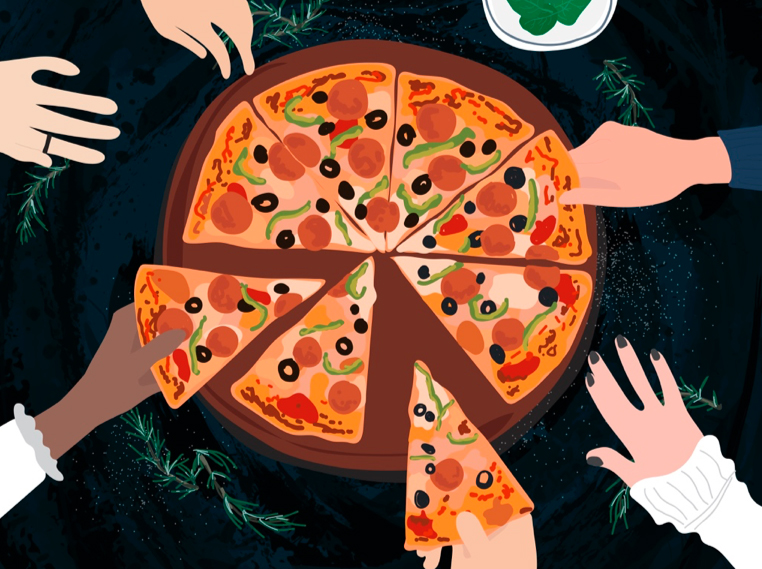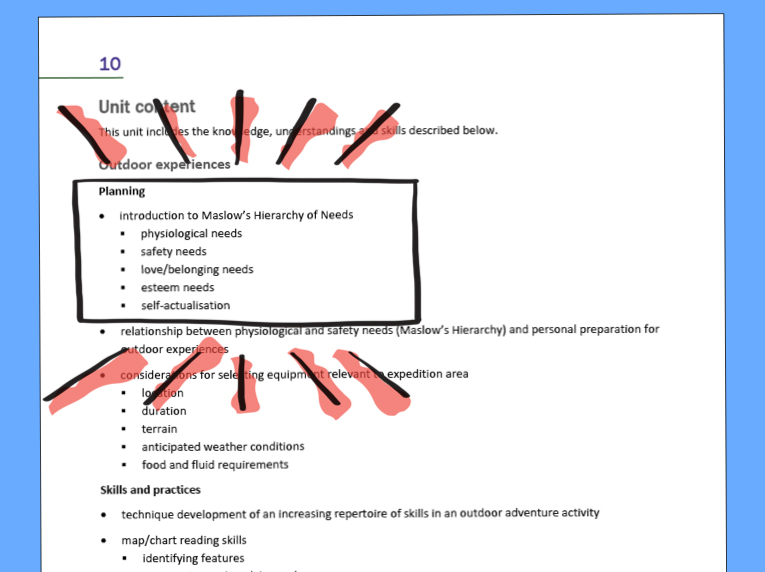
The other night I was reminded of just how crippling perfectionism can be.
My husband and I were at a party and we started chatting to a man about gardening. This man proudly told us he had spent thousands of dollars on gardening books over the last few years. He then proceeded to tell us everything he knew about gardening.
At one point in the conversation, I asked him the question:
“What are you growing in your garden at the moment?”
His response?
It didn’t make any sense to me. How could this man who knew so much about gardening not be growing a single thing?
Man: “Unless I have lots of land, I can’t grow anything”
Me: “But you can grow a lot in a small space. What about the some herbs in pots?”
Man: “No. I need lots of land …”
This man had every excuse under the sun for why he couldn’t start growing some herbs and tomatoes.
Now here’s where things got really interesting …
Me: “Why don’t you come visit our garden for some inspiration?”
Man: “No thanks. If I come, I’ll be highly critical of your garden.”
Me: (Confused look on face) “But we’re actually growing vegetables. You’re not growing anything …”
Man: “I know, it’s crazy but this is what I’m like. I’m a perfectionist.”
There was the answer to why this man wasn’t growing any vegetables or herbs. He said it himself. He had a debilitating case of perfectionism.
Writer Ann Lamott famously said:
“Perfectionism is the voice of the oppressor, the enemy of the people. It will keep you cramped and insane your whole life, and it is the main obstacle between you and a sh**ty first draft.”
This poor man was too afraid to take the first step. The thought of making a mistake was just too scary.
This got me thinking. You can have every book on a topic and know everything about a particular subject area, but none of that matters if you don’t apply that knowledge.
The former CEO of Yahoo! Carol Bartz knows all about this. She states:
“I happen to be a big gardener and if you don’t kill a lot of plants along the way, you don’t know how to garden.”
Similarly, you can know 100 different study strategies but if you never use them and just highlight and re-read your notes, where’s the benefit in that?
Knowledge is power … but only if you take action and integrate it into your life.

When you try something new there’s always a risk that things may not work out. Yes, you may kill your plants. Your vegetables may get attacked by bugs. But at least you’ll learn something in the process.

Remember, all experts once started out as complete amateurs. Everything takes practice.
Author Catherine Deveny has the right idea when she says:
“Great people do things. Mediocre people talk about doing things. Small people bag other people who are doing things.”
So go do things. Don’t get stuck in a perfectionist trap. Pick something and run with it!
What’s the worst that can possibly happen?
Share This:
Procrastination feels heavy.
But what if we could turn combating procrastination into a fun game?
Lately, when I catch myself avoiding a task, I’ll play a little game to see if I can get myself to move in the right direction.
I’ve discovered that it’s best to approach any task with a curious and playful mindset. If you take yourself too seriously, all the joy and fun can get stripped from the process.
Often, when I play this game, I surprise myself because the strategy works! I’ll be off and running with a task I procrastinated on for days.
But sometimes a strategy won’t work. That’s okay. When this happens, I usually take a little break before trying another approach.
I don’t claim to be a grandmaster at playing the game of combating procrastination. But these days, I can catch myself when procrastinating, notice the warning signs, and get moving in the right direction.
In this blog, I share how you can combat procrastination in a fun and playful way to fulfil your intentions and accomplish your goals.
Are you ready to play?
Let’s begin!
If you want to play this game of combating procrastination, you first need to understand what procrastination is and the rules of the game.
I recommend you play this game on your own so you’re not competing against anyone else. There’s no first or second place, no runners-up, and no one wins a trophy.
You can play with others, but it’s a collaborative game where you cheer each other on and gently coach each other into action.
It’s also a game that never ends because the work never ends. You are constantly learning and growing.
In her book ‘Procrastination: What it is, why it’s a problem and what you can do about it’ Dr Fuschia Sirois defines procrastination as:
“ . . . a common self regulation problem involving the unnecessary and voluntary delay in the start or completion of important intended tasks despite the recognition that this delay may have negative consequences.”

In other words, procrastination is:
Delaying a task + you know you are causing your Future Self pain and suffering.
There are some simple rules you need to understand to combat procrastination. Once you cement these rules in your brain, life becomes easier. Instead of experiencing constant resistance, you discover ease and flow.
Difficult work tends to bring up unpleasant emotions, such as boredom, stress, anxiety, fear, and frustration.
Most of us don’t like experiencing these feelings, so to repair our mood, we procrastinate. We avoid work and engage in easier, more fun tasks (e.g., scrolling through social media).
At the heart of combating procrastination is allowing yourself to sit with unpleasant feelings and push past them. Resist the urge to run to your devices. If you can do this, that’s 80% of the battle.
Pushing through the discomfort and making a start is a significant milestone worth celebrating.
Often, we wait for the perfect time to start a task. But it’s an illusion that there is a perfect time.
The perfect time is right now, amid the messiness and chaos of life.
“But I’m not feeling motivated!” I hear you say.
That’s okay. Make a start regardless of how you feel because here’s the part most people don’t understand:
Motivation follows action
In other words, you have to get moving for motivation to show up.
There are many great strategies and tools that can help you get started with a task, even when your motivation levels are low.
Once you have a selection of strategies and tools and you’ve practised using them a few times, you will feel more confident in your ability to combat procrastination.
Here are a few of my favourite strategies and tools for getting started with my work:
Fear is a significant driver of procrastination: fear that you won’t be able to do it, fear of failure, and fear of the unknown.
When you move your body, you decrease fear and anxiety. Movement can also help to calm and focus your mind and boost positive emotions.
This is why I start my day with a 20-30 minute run on my treadmill. It bathes my brain in feel-good chemicals, makes me feel stronger, and prepares me for the challenging work I’m about to face.
When a task feels big and overwhelming, it’s easy to procrastinate. But can you do 10 minutes on the task?
When I set a timer for 10 minutes, my brain thinks, “I can do 10 minutes. Easy!”
My brain then knows the task (and the unpleasant feelings) won’t last forever. The worst-case scenario is I experience 10 minutes of mild to moderate discomfort. When the timer goes off, I have a way out. I can do something else.
But what usually happens is after 10 minutes, I realise the task isn’t as bad as I thought it would be. The motivation has kicked in, and I’m on a roll.
When struggling to write my PhD, I attended a workshop led by an academic coach. She encouraged me to “Write crap” (her words, not mine).
This helped me to get over the perfection hump and make a start.
Most (if not all) great works started as rough drafts. The problem is we don’t see those rough early versions. We only see the polished final product. This messes with our minds and can lead to perfectionist tendencies kicking in.
Embrace the first messy draft. Celebrate it! You have to do it to get to the good stuff.
In the book ‘Everything in its Place’, Dan Charnas recommends the ‘Slow-but-don’t-stop’ technique for doing things you don’t want to do.
Here’s how it works:
If you’re feeling resistance towards a task, start doing it, but move very slowly. Breathe into the discomfort. Take your time.
Charnas writes that as you use this technique:
“You’ll still hate it [the task] but your task has become a moving meditation or like a game.”
For example, I used this strategy on the weekend to sort my laundry. The first step was to pick up the basket full of clothes and place it on my bed. Then, I picked up one item at a time and put them into piles (e.g., socks, activewear, and undies). I then selected a pile of items (socks) and dealt with one item at a time.
I’d usually rush to fold my clothes and feel slightly annoyed by the whole process (“Ugh, what a chore!”), but this time, it felt different. It felt like a meditation. I felt calm and grounded as I folded my socks.
The beauty of this technique is that the work will still get done, but as Charnas points out, you don’t give up control. You still have forward momentum.
As the Mexican proverb goes:
“An ant on the move does more than a dozing ox.”
Are there things in your workspace that distract you? Is there anything that reminds you of more fun stuff you could be doing (e.g., a video game console or your phone)?
Please get rid of those things or make them harder to access.
My phone is my biggest distraction. This is why I keep it away from my body in another room whenever I need to do focused work.
I’m currently experimenting with Mel Robbin’s 5-Second Rule. The 5-Second Rule is simple:
The moment you have the instinct to do a task before your brain can come up with an excuse not to do it, you count backwards ‘5 . . . 4 . . . 3 . . . 2 . . . 1!’ and you do it.
In her book ‘The 5 Second Rule’ Robbins explains the psychology underpinning the strategy. She writes:
“The counting distracts you from your excuses and focuses your mind on moving in a new direction. When you physically move instead of stopping to think, your physiology changes and your mind falls in line . . . the Rule is (in the language of habit research) a “starting ritual” that activates the prefrontal cortex, helping to change your behavior.”
The ultimate way to combat procrastination is to create a habit or a ritual. You need something that signals to your brain it’s time to engage in a particular behaviour.
With habits, you don’t have to stop and think, “What do I need to do now?”. Habits are automatic. Your brain knows exactly what it needs to do, and you do it.
For example, I have a habit of running on my treadmill before I launch into my day. My brain knows that after I put on my gym clothes and shoes, I turn on my treadmill and hit the speed button to start my warm-up.
I carry these behaviours out even when I’m not in the mood to run. That’s the power of habits.
Then, I suggest you cut yourself some slack.
Forgive yourself for procrastinating, pick a strategy, and get moving.
Most of us don’t do this, though.
We bag ourselves out in an attempt to motivate ourselves. The problem is this rarely works.
Dr Sirois says that intense self-criticism leads to negative thoughts, which lead to negative feelings. We end up feeling demotivated, which causes us to procrastinate even more!
You can stop the vicious cycle of procrastination by practising being kind to yourself.
If you follow these simple rules and be playful with experimenting with these strategies, you can get a better handle on procrastination.
Like anything in life, the key is practice. The more you practice allowing yourself to feel the unpleasant emotions instead of running from them, the better you’ll do. The more times you practice a strategy, the more natural it will feel and the sooner it will become a habit.
One foot in front of the other. You can do this.

In their minds:
Beautiful notes = effective exam preparation
But is this the most effective approach to take?
In her book An Insider’s Guide to BA [Bachelor of Arts] Rebecca Jury states:
“Would you sit your practical driver’s test without ever having practised driving a car? Preparing for an exam by only taking notes is like preparing for your restricted driver’s licence by only reading the Road Code. Bad idea.
You need to learn the theory and then practise in the medium in which you are going to be assessed.”
In short, if you want to do well in your exams then you’ll need to do practice exams.
When you do practice exams this . . .
• helps you see how well you understand the subject (it’s a reality check!)
• gives you the opportunity to do active recall (AKA retrieval practice)
• helps you to pinpoint gaps in your knowledge (which is 80% of the battle when it comes to learning)
• gives you a sense of the format and types of questions you’ll be asked
• helps you to build your confidence for the actual exam
But I understand the idea of gathering a pile of past papers and then sitting down to do them can be completely overwhelming.
So, we’re going to break this process down, step-by-step, so it’s not so scary for your brain.

You can gather past/sample exam papers in the following ways:
• Talk to your teacher: This is probably the easiest way to access exam papers. Simply ask your teacher if they have any practice exams and other resources they are willing to share with you.
• Trade exam papers with other students: Reach out to someone you know at another school who is studying the same subject and do a friendly exchange of resources (although I don’t recommend trading notes).
• Visit your State library: Most good libraries have past exam papers and study guides available for students. For instance, The State Library of Western Australia has an extensive selection of past exam papers, study guides, and Good Answer Guides (visit the WACE Study Space on Level 1).
• Government education websites: If you live in Australia, most state government departments that deal with curriculum provide past exam papers online that you can download:
Western Australian: School Curriculum and Standards Authority
Victoria: Victorian Curriculum and Assessment Authority
South Australia: South Australian Certificate of Education
Queensland: Queensland Curriculum and Assessment Authority
New South Wales: Education Standards Authority
Check in with your teacher to see what papers are most relevant. You don’t want to waste your precious time and energy doing a past paper that is based on an outdated syllabus.
• Study guides: These resources are usually created by experienced teachers who are familiar with the curriculum. You’ll want to check a few details before borrowing/purchasing a study guide:
1. What year was the study guide was published?
2. What’s the author’s background and level of experience?
3. Where are they based?
It makes a difference if the author is an experienced teacher who is familiar with your curriculum.
What if you can’t access any past papers and study guides?
Then, worst case scenario, you’ll need to make your own exam paper.
This doesn’t have to be anything fancy. All you need is a series of questions that will force you to bring the relevant information to mind.

Once you’ve gathered all your practice exam papers, do a lucky dip and pick one. Put all the other exam papers in another room (you’ll deal with them later).
Then, you need to commit to making a start on the practice exam you’ve just selected.
Here’s what you’ll need:
• A clear desk located in a place where you won’t get interrupted or distracted
• A timer
• Several good pens and anything else you’ll need to do the exam (e.g., calculator)
• A friend to share the pain with (optional)
You won’t need:
• Your books and notes
• Your phone
Here’s what you need to expect:
Expect to feel a little uncomfortable doing the practice exam. Chances are you won’t be able to answer several (or a lot) of the questions. You’ll probably feel a little awkward and clumsy, too. That’s okay. Relax. This is a normal part of the learning process.
Don’t like the idea of sitting for a full 2-3 hours to do the exam?
I get it! In fact, I wouldn’t recommend doing that.
It’s best to break it down into small chunks. You don’t want to slog it out in pain for hours on end. You’ll kill the habit before it has a chance to get established in your life.
• Set a timer for 25 minutes and make a start on some questions (without looking at your books and notes).
• Then take a 5 minute break.
• After your break, check to see how you went with the questions you just answered (take note of any weak areas).
• Take another 5 minute break.
• Dedicate some time and effort to improve on those weak areas (use effective study strategies to do this).
• In a few days time, test yourself again on those weak areas.
What you’re doing here is you’re using your the past papers as a tool to guide your study sessions.
If 25 minutes feels too hard, just select one question and do that. Doing one question is infinitely better than doing nothing!

The first exam paper can be a massive shock to your system. Chances are you’ll feel really rusty and you’ll struggle to answer many of the questions. This is normal.
It’s much better that you experience this shock now than in the actual exam. Stay strong and persevere through that first past paper!

It’s normal for your brain to feel a little fried after completing exam questions. This is why it’s super important to say to yourself things like, “Great job!” and “Keep going champion!” after you finish answering each question.
Also, give your brain regular breaks. Set a timer and go do something fun and/or pleasurable. Make a smoothie. Go for a walk. Crank up some music. When the timer goes off, get stuck into answering another exam question or make a start on studying one of your weak areas.

Once you’ve done a few past exam papers for a subject (spaced out over a couple of weeks), you’ll begin to see common themes/topics emerge. Now is a good time to take out your syllabus. Your syllabus, specifically the unit content section, tells you exactly what you need to know for the exam.
Arm yourself with a highlighter or a coloured pen and head straight to the unit content section.
Have a read through this section. If a concept is unfamiliar to you, take note. This is an area you’ll want to look at in a future study session.
Why bother doing this?
Because you’re checking that you’ve covered all your bases. You’re future proofing yourself so there are no nasty surprises in the final exam.
If you take this approach (i.e., doing past papers), you’ll do better than the student who spent all their time making beautiful sets of notes.
Yes, it can be a little painful and a bit of a shock to the system to do a practice exam. But remember, it’s better to experience the shock now than in the actual exam!
When many of us thought we’d be returning to a ‘normal’ existence this year, the reality has hit us hard: returning to ‘normal’ is not going to happen (at least not anytime soon).
Over the last few weeks, I’ve heard some self-help gurus and influencers make the following claims:
• “You are the creator of your own destiny”
• “You can do anything you put your mind to”
• “If you just visualise what you want, the universe will manifest it into being!”
Alarm bells go off for me whenever I hear these sorts of statements.
Yes, I somewhat agree. If you focus your mind, have clear goals, effective strategies and consistently engage in the right behaviours, you’ll be amazed by what you can achieve.
But I get a little annoyed when these ideas are presented in an overly simplistic way. What many self-help gurus and influencers fail to do is give people practical tools and evidence-based strategies that will help them to change their behaviour and reach their goals.
Without practical tools and strategies, we are setting people up to fail.
Stanford University Professor BJ Fogg states in his book Tiny Habits:
“For too many years, myths, misconceptions, and well-meaning but unscientific advice have set you up to fail. If you’ve attempted change in the past and haven’t seen results, you may have concluded that change is hard or that you can’t succeed because you lack motivation. Neither is accurate. The problem is with the approach itself, not with you.”
In this blog post, I’m going to share Professor BJ Fogg’s simple but powerful method for changing behaviour: tiny habits.
When life feels hard and you’re struggling to find the motivation to get through the day, you need to scale things right back.
How do you do that?
You need to make whatever you need to do seem really easy for your brain. This is where tiny habits come in.
A tiny habit is a behavior that can be performed in less than 30 seconds and requires little or no willpower. The radically small behaviour sets you on a path to achieving your goals.
Tiny habits allow you to have a predetermined plan for each day. Without tiny habits, you can wear yourself out just deciding what to do. Tiny habits automate your behaviour and make it easy for you to get on with doing what you need to do.
According to Professor BJ Fogg, a tiny habit is made up of three key parts:
• An anchor moment (i.e., prompt).
• A tiny version of a desired new behaviour.
• An instant celebration.
I’ll unpack each of these parts before bringing it all together with a few examples from my own life.
An anchor moment is a pre-existing habit that reminds you to carry out the new tiny behavior. Examples of common anchor moments include putting on your shoes, brushing your teeth, having dinner, checking your phone, and taking a shower.
Anchor moments are solid and reliable parts of your daily routine. You do them every day without fail. These routines act as a trigger for the new tiny behaviour, propelling you into action.
The tiny behaviour should require little to no effort or willpower to carry out. For example, if the desired behaviour is to floss your teeth, the tiny behaviour would be to floss one tooth. If you want to do more than the tiny version, go for it. But consider that’s a bonus extra. By carrying out the tiny behavior every day, you keep the habit alive and give it a chance to establish solid roots in your life.
If you want to fast track habit formation, you must do one simple thing — celebrate. Milliseconds after you engage in the new behaviour, you need to release a positive emotion. Instantly.
It’s this instant release of good feelings that will remind you to do the behaviour again in the future.
What does celebration look like? Here are some ideas from my own life:
• Do a fist pump.
• Say out loud “Shazam!”.
• Say “Winner winner chicken dinner!”.
• Drum a punchy beat on the table.
The following is a list of tiny habits that help me to think, feel and function better. These tiny habits are focused around eating well, moving my body, getting plenty of rest, decreasing stress and managing my mindset.
1. After I make my bed, I will put on my walking shoes on.
2. After I have my breakfast, I will think of three things I feel grateful for.
3. After I put on my walking shoes, I will have a sip of water.
4. After I finish a writing session, I will take out a broccoli to chop.
5. When I arrive at a school, I will sanitise my hands and carefully put my mask on.
6. When I open up Zoom (or Teams) to deliver a presentation, I will take a deep breath and say “You can do this!”
7. After I set my intentions/goals for the day, I will put my phone away from my body (in another room).
8. When I find myself feeling overwhelmed, I will take out a post-it note and write down one thing I can do.
9. When my head hits the pillow, I will write down three things that went well today.
10. When I find myself feeling stressed, I will do a big sigh.
11. When I find myself feeling stuck, I will think “Who can I ask for help?”
These tiny habits are currently working for me. But they may not work for you. You can design your own tiny habits from scratch by pairing up anchor moments with desired tiny behaviours (don’t forget to celebrate!).
Alternatively, you can create your own tiny habit recipes by using the Tiny Habits Recipe Maker.
You can also check out Dr BJ Fogg’s great book Tiny Habits (there is a long list of tiny habits at the back of the book).
Visualising what you want is never going to be enough to make it happen. You need to be in action. I’ve found the tiny habits method to be a great way to shift from inaction to action, especially during challenging times.
Like anything in life, using tiny habits requires practice. But the more you practice this skill, the better you’ll get. And the better you get, the better you’ll start to feel about yourself and what you’re doing.
Dr Jane Genovese delivers interactive and engaging study skills sessions for Australian secondary schools. She has worked with thousands of secondary students, parents, teachers and lifelong learners over the past 15 years.
Get FREE study and life strategies by signing up to Dr Jane’s newsletter:
© 2025 Learning Fundamentals